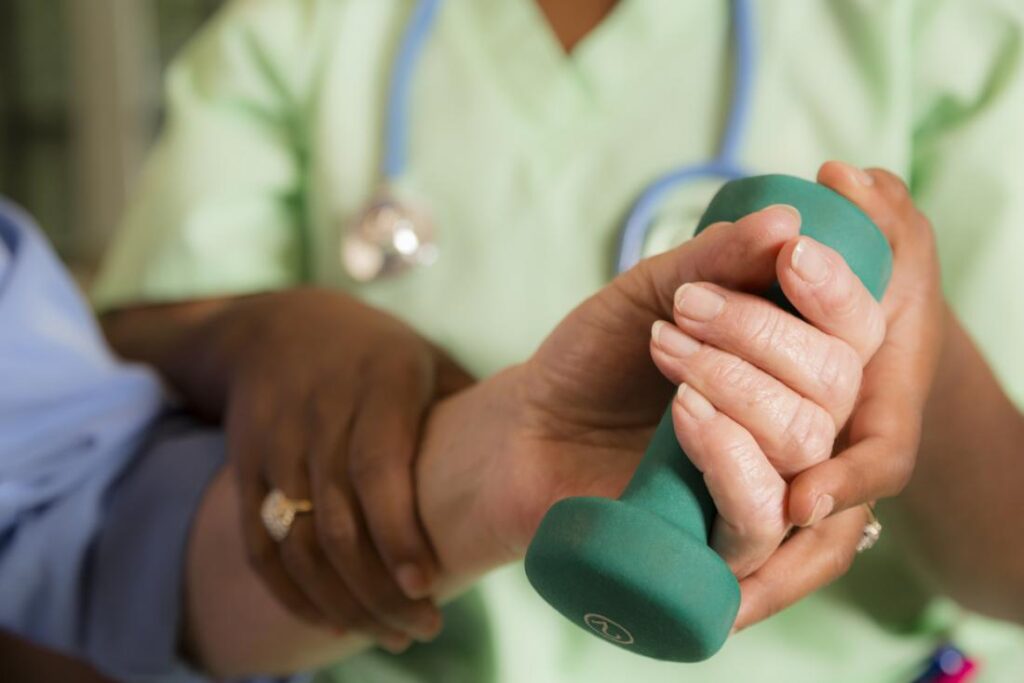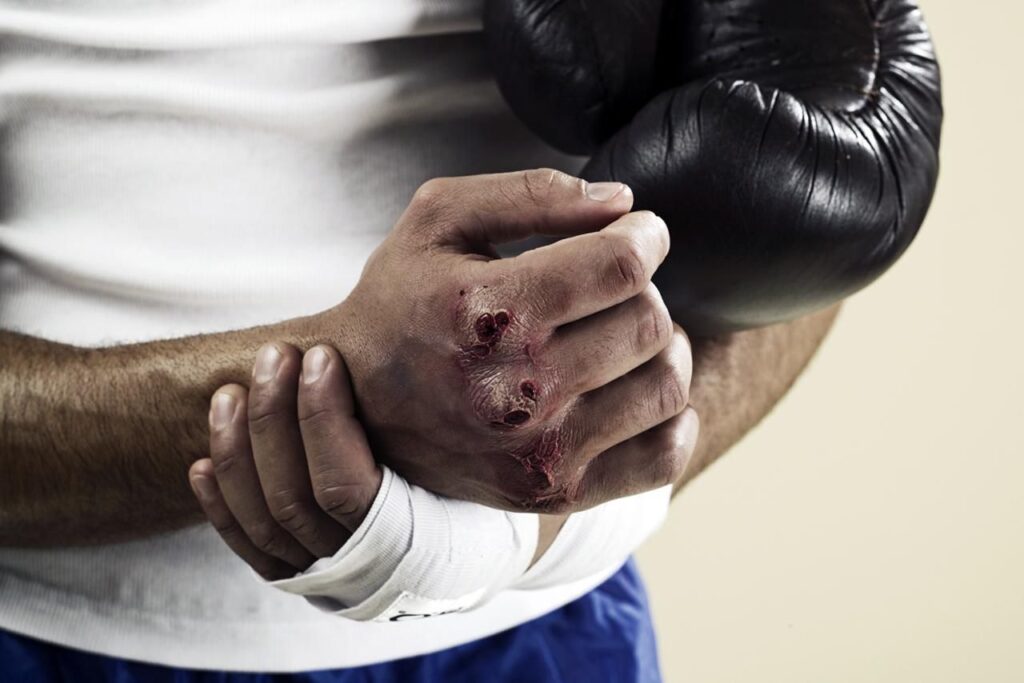Have you ever punched something so hard that you broke your hand? If that rings a bell, you may have encountered what’s known as a boxer’s fracture. It is commonly caused when you punch something with a clenched fist.
One of the common symptoms of the boxer’s fracture is painful bruising and swelling. The bruising can get pretty intense, sometimes making its way up to your elbow. Bruises happen when the tiny blood vessels in our skin are broken releasing blood to the surrounding tissues.
If you’ve found yourself in such a situation you are most likely to have a taste of boxer’s fracture bruising. This makes it crucial to consult a doctor who can diagnose the fracture and recommend treatment options.
As a hand surgeon, I know how painful and frustrating it can be to have a broken hand. That’s why I’m here to offer you a detailed picture of what a boxer’s fracture is, from the bruises to other vital aspects such as:
- What is a boxer’s fracture?
- What are the symptoms
- Treatment for Boxer’s fracture
- boxer’s fracture splint
- How long does a boxer fracture last? And many more
What is a boxer’s fracture?
Boxer’s fracture is also known as the fifth metacarpal fracture. A boxer’s fracture is a break in the neck of the 5th metacarpal bone in the hand. The condition is so named because it is common in inexperienced boxers. It is most frequent in men and usually affects the small (pinky) or ring finger.
Boxers are not the only persons who can develop a boxer’s fracture, but the injury is frequently caused by a direct injury to a clenched fist. This can happen if you punch a wall or another solid item at a high speed
What are the symptoms of Boxer’s fracture?
- Painful bruising and swelling in the back and front of the hand. The area around the fracture might turn various shades of purple, green, and yellow as the days progress.
- Inability to move the pinky finger or the ring finger
- Difficulty in gripping objects with the injured hand or clenching your fist.
- Some visible deformities could be observed as the knuckle appears misaligned or out of place, it’s a clear indicator that something’s amiss.
- Coldness in the hand or even feel numbness.
How doctors diagnose the condition
Your injuries will be evaluated by your doctor. First doctors go for a physical examination of your hand, checking for pain, strength, and misalignment. They will ask you how the injury occurred, and about your symptoms which provides them with crucial insights.
Now to confirm the diagnosis, you certainly require an X-ray which determines whether the bone is broken and if it’s broken in the fifth metacarpal’s neck. The doctor will need to confirm that it isn’t another bone that has broken or is broken in a different location. This extra attention in diagnosis is required since treatment differs for different types of broken bones.
Treatment for Boxer’s fracture?
No two fractures are the same. So the treatment for one fracture may not be suitable for the other. Depending on the severity of the fracture based on his diagnosis, your doctor recommends a suitable treatment approach.
For minor fractures where the bones are slightly misaligned, some conservative treatment would help, like
- Immobilizing the hand using a splint or cast to allow the bone to heal naturally
- Applying ice to the injured area helps you relieve pain.
- Taking medications as prescribed by your doctor.
- Some home exercises are recommended by your doctor to regain strength in your hand. Only after the splint or cast is removed.
But in some extreme cases where the bones are significantly displaced or if the fracture is unstable, surgical intervention is crucial and needed for successful recovery. Surgical treatments can be recommended in instances when bones show signs of angulation – where part of the metacarpal moves out of alignment.
Surgical procedures involve realigning the bones and securing them with pins, screws, or plates. While surgery might sound intimidating, it’s often the fast track to regaining optimal hand function and minimizing the risk of long-term complications.
Recovery stage
Regardless of the chosen treatment path, one should understand that it takes time and a positive attitude toward the treatments. You might be eager to get back in the ring or back to your daily activities, but rushing the healing process could lead to setbacks.
Your doctor will advise you on the best time to resume full physical activity and may recommend physical therapy to help you regain strength and mobility.
Boxer’s fracture bruising

Hope you remember how a boxer’s fracture occurs with what we have discussed earlier. If you are inexperienced, a speedy and strong punch causes damage to your knuckles and damages the underlying blood vessels. Bruises form when small blood vessels near the skin’s surface are broken. This releases blood into the surrounding tissues and causes bruising appears on the canvas of your skin.
The bruising could first appear as reddish or purple appearance(dark mark) as fresh blood seeps into the tissues. Later the bruise might turn bluish or greenish, signaling the breakdown of blood components. Finally, the bruises take on a yellowish tint as your body effectively clears away the remnants of the blood, allowing the tissue to heal.
By observing the changes in color and size of the bruises over time, you’re witnessing your body’s remarkable ability to mend itself.
What is a boxer’s fracture splint?
When you’re dealing with a boxer’s fracture, your hand needs more than just time to heal. It needs support, gentle correction, and freedom to recover without unnecessary strain.
Boxer’s fracture splint is a specially designed apparatus that provides stability, immobilization, and protection to your injured hand. The splint helps hold your fingers and hand in a position that prevents further movement. This strategic immobilization creates the ideal condition for healing.
Also, the splint prevents any accidental impact that further worsens the injury or disrupts the healing process.
Wearing a splint might seem like a temporary inconvenience, but it’s a small investment with substantial returns.
How long does a boxer fracture last?
The duration of healing can vary from person to person. Also depends on a variety of factors, such as the severity of the fracture, your age, overall health, and your approach toward the treatment procedures.
In most cases, the boxer’s fracture usually heals within 4-6 weeks but may require more time to regain strength. However, keep in mind that this is a general timeline. Some fractures heal sooner, while others may take more time. But don’t worry with time you will be back to your daily routine.
Can a boxer’s fracture heal naturally?
The straightforward answer is no, you cannot just simply leave it to heal on its own. There is a need for proper intervention from a healthcare professional to guide you through the treatment process whether surgical or non-surgical.
The untreated boxer’s fracture can decrease the grip strength, affecting the range of motion of the fingers or wrist, or even causing crooked fingers.
How do I know if my boxer’s fracture is healing?
- A gradual reduction in pain and swelling
- Mobility of your hand improves and better gripping strength
- Bruising started to heal, and you feel like getting more flexibility and strength in your hand.
Conclusion
I hope as we reached the end of our journey starting with understanding what a boxer’s fracture is, its symptoms, and treatments, and all the way to addressing some of the common questions, you got a better understanding of the condition and how to deal with it.
Whether you’re a seasoned fighter or someone who simply enjoys the thrill of a well-landed punch, your hand is more than just tools – they are the symbol of your determination and strength.
Remember the healing journey might be a marathon, not a sprint. We may see some recover faster while others take time. Don’t compare yourself with others, stay consistent, stay engaged in your healing routine, and trust in the incredible healing power of your body.

